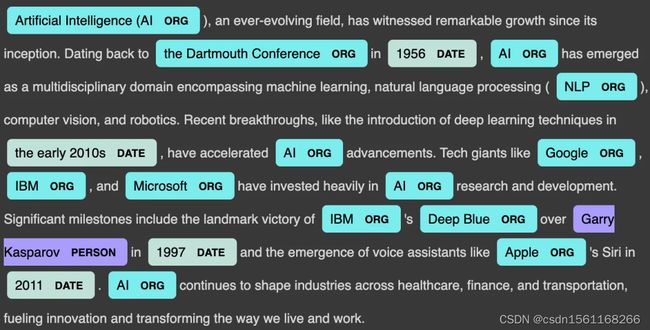基于Python和Spacy的命名实体识别
命名实体识别(Named Entity Recognition,简称NER)是一种自然语言处理(NLP)方法,用于检测和分类文本中的命名实体,包括人物、组织、地点、日期、数量和其他可识别的现实世界实体。
Spacy是一个基于Python的开源自然语言处理库,提供广泛的功能,包括标记化、POS标签、句法分析、命名实体识别、文本分类等。它具有预训练模型和灵活的API,受到自然语言处理专业人士和研究人员的广泛青睐。
'''
Prefix the install statements with an exclamation if you are using
Jupyter Notebook or Google Collab interface.
'''
!pip install -U pip setuptools wheel
# 使用pip安装gpu版本的spacy(有关cpu版本的安装,请参考spacy文档)
!pip install -U 'spacy[cuda-autodetect]'
# 安装基于Transformer的预训练语言模型(英语)
!python -m spacy download en_core_web_trf
# 安装基于CPU优化的管道(英语)
!python -m spacy download en_core_web_sm如果你正在使用Google Colab或配备GPU的计算机,则后续操作将涉及将运行时类型切换为GPU。否则,如果你使用的是基于CPU的安装,则可以继续使用CPU运行时类型。让我们在以下示例文本上执行NER。
用作示例的输入文本:
“Artificial Intelligence (AI), an ever-evolving field, has witnessed remarkable growth since its inception. Dating back to the Dartmouth Conference in 1956, AI has emerged as a multidisciplinary domain encompassing machine learning, natural language processing (NLP), computer vision, and robotics. Recent breakthroughs, like the introduction of deep learning techniques in the early 2010s, have accelerated AI advancements. Tech giants like Google, IBM, and Microsoft have invested heavily in AI research and development. Significant milestones include the landmark victory of IBM’s Deep Blue over Garry Kasparov in 1997 and the emergence of voice assistants like Apple’s Siri in 2011. AI continues to shape industries across healthcare, finance, and transportation, fueling innovation and transforming the way we live and work.”
我们将使用两个不同的模型,每个模型都有特定的目的。其中一个模型(“en_core_web_sm”)注重效率,另一个模型(“en_core_web_trf”)注重准确性。
# 导入依赖项
import spacy
sample_text = "Artificial Intelligence (AI), an ever-evolving field, has witnessed remarkable growth since its inception. Dating back to the Dartmouth Conference in 1956, AI has emerged as a multidisciplinary domain encompassing machine learning, natural language processing (NLP), computer vision, and robotics. Recent breakthroughs, like the introduction of deep learning techniques in the early 2010s, have accelerated AI advancements. Tech giants like Google, IBM, and Microsoft have invested heavily in AI research and development. Significant milestones include the landmark victory of IBM's Deep Blue over Garry Kasparov in 1997 and the emergence of voice assistants like Apple's Siri in 2011. AI continues to shape industries across healthcare, finance, and transportation, fueling innovation and transforming the way we live and work."
# 加载用于更好效率的普通模型。
nlp = spacy.load("en_core_web_sm")
# 预测实体
text = nlp(sample_text)
# 在jupyter模式下显示文本和突出的实体
spacy.displacy.render(text, style="ent", jupyter=True)输出:
使用Spacy的可视化工具和en_core_web_sm模型的实体可视化输出
# 使用基于Transformer的模型进行NER
# 使用spaCy加载基于Transformer的管道(roberta-base)
nlp_trf = spacy.load('en_core_web_trf')
# 对模型进行推断
text = nlp_trf(sample_text)
# 使用jupyter模式显示文档
spacy.displacy.render(text, style="ent", jupyter=True)使用Spacy的可视化工具和en_core_web_trf模型的实体可视化输出
基于Transformer的模型在对比中显示出更低的错误率,因为它将“AI”和“NLP”准确识别为“ORG”实体,将“Siri”识别为“PRODUCT”,将“The Dartmouth Conference”识别为“EVENT”。这验证了Transformer的卓越性能。
NER广泛适用于不同行业中,可以提取洞察信息并促进决策制定。以下是具体的用例:
-
医疗保健:NER从临床记录中提取医学实体(疾病、症状),帮助信息检索、诊断和治疗规划。
-
金融业:NER从文章和报告中识别实体(公司名称、金融术语),支持市场分析和投资决策。
-
电子商务:NER从评论中提取产品名称、品牌和属性,增强情感分析和个性化推荐。
-
媒体和出版:NER对文章和社交媒体中的实体(人物、地点)进行分类,实现内容分类和趋势分析。
-
法律:NER在文件中识别法律实体(案件名称、法规),简化研究和合同分析。
-
旅游和酒店业:NER从评论中提取位置名称、地标,支持情感分析和个性化推荐。
-
政府:NER在文件和社交媒体中识别实体(机构、地点),协助政策分析和情感监测。
-
CRM:NER从互动中提取客户详细信息,增强客户画像、潜在客户生成和销售管理。
这些案例展示了NER的广泛适用性,提供了洞察信息,并增强了运营效率。

